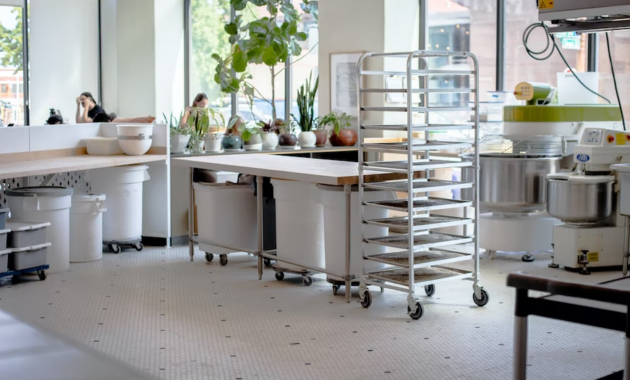Shared commercial kitchens, also known as shared-use, community, or incubator kitchens, are facilities that offer kitchen equipment and spaces for individuals and businesses, especially start-up and small-scale food producers, to be licensed and produce food for the public. These shared kitchens offer the necessary equipment and spaces required for a food license, such as approved surfaces, stainless steel tables, refrigeration, warewashing facilities, handwashing sinks, range and oven, pots and pans, and other equipment. This article will explore what shared kitchens are, how to determine if a shared kitchen model is right for you, the anatomy of a shared kitchen, how to choose the right kitchen for you, the costs of a shared kitchen, and where to find shared kitchens.
Shared kitchens can be anything from another restaurant with kitchen space available on certain days and times to large commissary kitchens open to all sorts of food entrepreneurs. Shared kitchen facilities can vary widely in size and amount of available cooking equipment and storage, both dry and refrigerated. The type of clients they serve also varies from one location to another. Some shared kitchens are geared primarily toward bakers, for example; others are for food truck operators, and some are for retail food startups, in addition to caterers.
Commissary kitchens pay all the bills for utilities, pest control, security, etc. They provide good commercial grade equipment and maintain it. While you need your own business license and food handler’s permit, shared kitchens make it easy to stay compliant with local health codes—they’re responsible for passing inspections. Shared kitchens provide a sense of community where you can benefit from the advice and experience of fellow operators. Commissaries often provide additional services such as kitchen staff and incubator programs that can help you grow your business faster.
Renting kitchen space makes the most sense when you simply don’t have the room or the right equipment to cater an event. The advantage of a shared kitchen is that you only use and pay for it when you need it, so you don’t have the overhead of maintaining that space and equipment yourself. Still, rates to use shared kitchen spaces vary, and you’ll need to determine if the event is large enough to generate the income necessary to offset your costs. If you’re catering small parties, a shared kitchen may make less sense; instead you might be able to find a restaurant willing to give you time in its kitchen during off-hours, either for a smaller fee or in trade for something you can offer the restaurant.
Depending on location, shared kitchens can range from small spaces of less than 1,000 sq. ft. to massive communal food enterprises of more than 30,000 sq. ft. You’ll find an equally diverse range of equipment in these spaces, too, so it pays to do your homework. In larger cities, you may have dozens of shared kitchens to choose from, usually ensuring you’ll find exactly what you need. Smaller markets, not surprisingly, have fewer shared kitchen facilities to choose from, but they may still offer a variety of options.
Before deciding if a shared kitchen model is right for you, consider the type and volume of food you’ll be producing, as well as your budget. Shared kitchens can be a great option for entrepreneurs who need to test their business concept, want to avoid the high overhead costs of a brick-and-mortar establishment, or want to scale up their operation without investing in expensive equipment and space. However, shared kitchens may not be the best fit for everyone, especially those who need a lot of space or have specific equipment needs.
The anatomy of a shared kitchen typically includes a variety of equipment, such as commercial-grade ovens, ranges, fryers, refrigerators, and freezers. Many shared kitchens also provide smallwares such as pots, pans, and utensils, as well as storage space for ingredients and finished products. Depending on the facility, shared kitchens may also offer office space, meeting rooms, and educational resources such as workshops and mentorship programs.
When choosing a shared kitchen, it’s important to consider factors such as location, hours of operation, available equipment, storage space, and cost. Some shared kitchens require a minimum amount of usage per month, while others charge hourly or daily rates. Additionally, some shared kitchens may require you to bring your own smallwares or purchase them from the facility.
The costs of using a shared kitchen can vary widely depending on the facility and the services provided. Some shared kitchens charge a flat monthly fee that includes access to equipment, storage space, and utilities, while others charge hourly rates that may or may not include equipment and storage. In addition to these costs, entrepreneurs using shared kitchens should also factor in the cost of ingredients, packaging, and other materials needed to produce their products.
If you’re interested in using a shared kitchen, there are several resources available to help you find one in your area. Many shared kitchens have websites or directories where you can learn more about the facility and its services. Additionally, organizations such as KitchenTown and the Incubator Kitchen Collective provide support and resources for food entrepreneurs, including access to shared kitchens.
In conclusion, shared kitchens can be a great option for food entrepreneurs who need access to commercial-grade equipment and space but don’t want to invest in their own facility. By renting kitchen space, entrepreneurs can reduce overhead costs and test their business concept before investing in a brick-and-mortar establishment. However, it’s important to carefully consider the type and volume of food you’ll be producing, as well as your budget and equipment needs, before deciding if a shared kitchen model is right for you. With the right research and preparation, shared kitchens can be a valuable resource for food entrepreneurs looking to grow their business.










